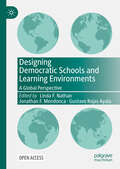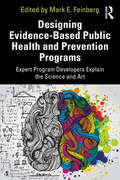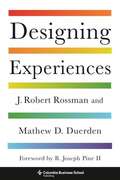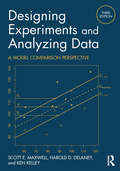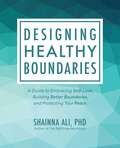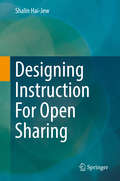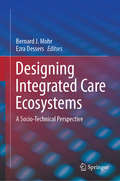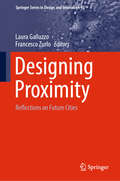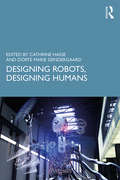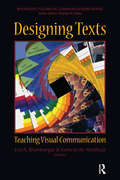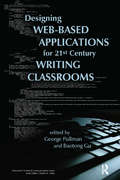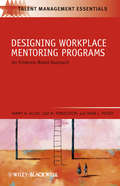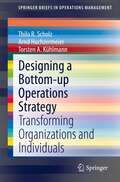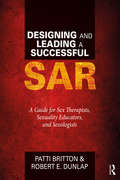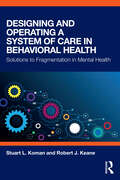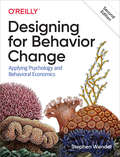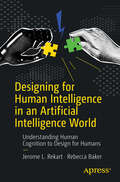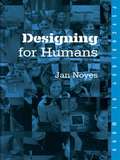- Table View
- List View
Designing Democratic Schools and Learning Environments: A Global Perspective
by Linda F. Nathan Jonathan F. Mendonca Gustavo Rojas AyalaThis open access book explores democratic schools and learning environments globally. The book focuses on a newly developed framework for democratic education. The authors describe existing schools and concept schools—those that are ideas but not in operation. The first section includes the editors’ own journeys Pillar One includes schools that emphasize the open flow of ideas and choices, regardless of their popularity. Pillar 2 maintains that it is impossible to have a high quality education that ignores equity. Chapters explore how many diverse ‘marginalized’ communities experience education and some innovations that hold great promise for inclusion. Pillar 3 provides examples of schools where active engagement, consensus and compromise support the ‘common good.’ Pillar 4 investigates schools which organize students, parents, social institutions and the larger community collaboratively to achieve its goals and to solve theirs and society’s most urgent challenges.
Designing Effective Digital Learning Environments (New Perspectives on Learning and Instruction)
by Andreas Gegenfurtner Ingo KollarBringing together the research of leading international scholars in the field of digital learning, Designing Effective Digital Learning Environments discusses cutting-edge advancements in digital technology and presents an evidence-informed summary of best practices for effective design principles and implementation within educational settings.Readers will benefit from a synthesis of research evidence from previous meta-analyses on how to design digital environments that support learning, motivation, and collaboration. Divided into eight thematic parts, chapters unpack: An introduction to the design of digital learning environments Learning with multimedia, with particular emphasis on digital reading comprehension environments and GeoGebra software Digital videos for learning, including dynamic visualizations, instructional videos, and eye movement modeling examples Simulated realities, including learning with pedagogical agents and immersive virtual reality environments Game-based and sensor-based learning in digital environments Digital learning in social contexts, including a discussion of CSCL, social media, and audience response systems Design of digital classrooms, including flipped classroom approaches and synchronous online learning A concluding section discussing the efficacy and design of digital learning environments This edited volume is an essential read for any scholar, researcher, Ph.D., or Masters student working in the field of digital learning.
Designing Evidence-Based Public Health and Prevention Programs: Expert Program Developers Explain the Science and Art
by Mark E. FeinbergDemonstrating that public health and prevention program development is as much art as science, this book brings together expert program developers to offer practical guidance and principles in developing effective behavior-change curricula. Feinberg and the team of experienced contributors cover evidence-based programs addressing a range of physical, mental, and behavioral health problems, including ones targeting families, specific populations, and developmental stages. The contributors describe their own professional journeys and decisions in creating, refining, testing, and disseminating a range of programs and strategies. Readers will learn about selecting change-promoting targets based on existing research; developing and creating effective and engaging content; considering implementation and dissemination contexts in the development process; and revising, refining, expanding, abbreviating, and adapting a curriculum across multiple iterations. Designing Evidence-Based Public Health and Prevention Programs is essential reading for prevention scientists, prevention practitioners, and program developers in community agencies. It also provides a unique resource for graduate students and postgraduates in family sciences, developmental psychology, clinical psychology, social work, education, nursing, public health, and counselling.
Designing Experiences (Columbia Business School Publishing)
by J. Rossman Mathew Duerden B. PineIn an increasingly experience-driven economy, companies that deliver great experiences thrive, and those that do not die. Yet many organizations face difficulties implementing a vision of delivering experiences beyond the provision of goods and services. Because experience design concepts and approaches are spread across multiple, often disconnected disciplines, there is no book that succinctly explains to students and aspiring professionals how to design them. J. Robert Rossman and Mathew D. Duerden present a comprehensive and accessible introduction to experience design. They synthesize the fundamental theories and methods from multiple disciplines and lay out a process for designing experiences from start to finish. Rossman and Duerden challenge us to reflect on what makes a great experience from the user's perspective. They provide a framework of experience types, explaining people's engagement with products and services and what makes experiences personal and fulfilling. The book presents interdisciplinary research underlying key concepts such as memory, intentionality, and dramatic structure in a down-to-earth style, drawing attention to both the macro and micro levels. Designing Experiences features detailed instructions and numerous real-world examples that clarify theoretical principles, making it useful for students and professionals. An invaluable overview of a growing field, the book provides readers with the tools they need to design innovative and indelible experiences and to move their organizations into the experience economy. Designing Experiences features a foreword by B. Joseph Pine II.
Designing Experiments and Analyzing Data: A Model Comparison Perspective, Third Edition (The\inquiry And Pedagogy Across Diverse Contexts Ser.)
by Scott E. Maxwell Harold D. Delaney Ken KelleyDesigning Experiments and Analyzing Data: A Model Comparison Perspective (3rd edition) offers an integrative conceptual framework for understanding experimental design and data analysis. Maxwell, Delaney, and Kelley first apply fundamental principles to simple experimental designs followed by an application of the same principles to more complicated designs. Their integrative conceptual framework better prepares readers to understand the logic behind a general strategy of data analysis that is appropriate for a wide variety of designs, which allows for the introduction of more complex topics that are generally omitted from other books. Numerous pedagogical features further facilitate understanding: examples of published research demonstrate the applicability of each chapter’s content; flowcharts assist in choosing the most appropriate procedure; end-of-chapter lists of important formulas highlight key ideas and assist readers in locating the initial presentation of equations; useful programming code and tips are provided throughout the book and in associated resources available online, and extensive sets of exercises help develop a deeper understanding of the subject. Detailed solutions for some of the exercises and realistic data sets are included on the website (DesigningExperiments.com). The pedagogical approach used throughout the book enables readers to gain an overview of experimental design, from conceptualization of the research question to analysis of the data. The book and its companion website with web apps, tutorials, and detailed code are ideal for students and researchers seeking the optimal way to design their studies and analyze the resulting data.
Designing Healthy Boundaries: A Guide to Embracing Self-Love, Building Better Boundaries, and Protecting Your Peace
by Shainna AliTake control of your relationships with this all-in-one guide to identifying, setting, and—most of all—maintaining healthy boundaries with your family, coworkers, friends, partner, and self.Well-designed boundaries are an essential component of living a happy, healthy, and balanced life. But while you may know that boundaries are important, it can often be confusing and intimidating to understand where, when, how, and with whom to build and maintain boundaries. To help, Dr. Shainna Ali, mental health counselor, educator, and best-selling author of The Self-Love Workbook offers Designing Healthy Boundaries, a comprehensive guide to incorporating self-love into building your boundaries. How you perceive, value, and respect yourself all influence the effectiveness of your boundaries. This approach will help you set limits that are more deeply aligned with your personal values, yourself, and your relationships. Through interactive activities, reflection prompts, and case examples, this workbook will help you explore what boundaries look like in your life and create more meaningful, rewarding connections through the art of boundaries.
Designing Instruction For Open Sharing
by Shalin Hai-JewThis textbook considers and addresses the design of online learning objects, electronic textbooks, short courses, long courses, MOOC courses, and other types of contents for open sharing. It also considers the design of online mediated communities to enhance such learning. The “openness” may be open-access, and/or it may even be open-source. The learning may range from self-directed and automated to AI robot-led to instructor-led. The main concept of this work is that design learning for open sharing, requires different considerations than when designing for closed and proprietary contexts. Open sharing of learning contents requires a different sense of laws (intellectual property, learner privacy, pedagogical strategies, technologies, media, and others). It requires different considerations of learner diversity and inclusion. It requires geographical, cultural, and linguistic considerations that are not as present in more localized designs. The open sharing aspect also has effects on learner performance tracking (assessments) and learner feedback. This textbook targets students, both undergraduate and graduate in computer science, education and other related fields. Also, professionals in this field managing online systems would find this book helpful.
Designing Integrated Care Ecosystems: A Socio-Technical Perspective
by Bernard J. Mohr Ezra DessersThis book brings together research and theory about integrated care ecosystems with modern Socio-Technical Systems Design. It provides a practical framework for collaborative action and the potential for better care in every sense. By combining the aspirations, information, resources, activities, and the skills of public and private organizations, independent care providers, informal care givers, patients and other ecosystem actors, this framework makes possible results that none of the parties concerned can achieve independently It is both a design challenge and a call for innovation in how we think about health care co-creation. Illustrative stories from many countries highlight different aspects of integrated care ecosystems, their design and their functioning in ways that allow us to push the operating frontiers of what we today call our health care system. It explains what it means to design higher levels of coordination and collaboration into fragmented care ecosystems and explores who the participants should and can be in that process. Written for a broad audience including researchers, professionals, and policy makers, this book offers readers new thinking about what outcomes are possible and ways to achieve them.
Designing Luxury Brands: The Art and Science of Creating Game-Changers (Management for Professionals)
by Diana DervalThis book, a second offering after the successful first edition, shows how to build successful luxury brands using the power of sensory science and neuropsychology. The author presents inspiring business cases like Tesla Cybertruck, Chanel, KaDeWe, Baccarat, JACQUEMUS, NASA, MUD Jeans, Lilium, Rémy Cointreau, FENG J, Moncler, Louboutin, or Raffles Dubai in industries such as Fashion, Automotive or Leisure. The book highlights groundbreaking scientific methods - like the Derval Color Test® taken by over 30 million people - to help predict luxury shoppers’ preferences and purchasing patterns. Game-changing and unique features of successful luxury brands are decoded. Through various practical examples and experiments, readers will be able to build, revamp, or expand luxury brands and look at luxury from a new angle.
Designing Mental Health Services for Children and Adolescents: A Shrewd Investment (International Association for Child and Adolescent Psychiatry and Allied Professions Leadership Ser. #Vol. 12)
by J. Gerald Young Pierre FerrariAn exceptional opportunity is being missed. A chance to alleviate suffering and to achieve health care cost reductions for society is available, but is being ignored. There is an explosion of new knowledge about the emotional and intellectual development of children, and the causes and treatment of psychiatric disorders of children and adolescents. Research from diverse disciplines such as the developmental neurosciences, psychoanalysis, psychopharmacology, developmental psychology, and genetics propels us forward,. However, the effects of this new knowledge reach children and adolscents slowly, or not at all. The long history of neglect of the mental health of children and adolescents is now exaggurated by sudden, disruptive economic and political influences on mental health services for children and adolescents in most countries. Prevention and treatment of emotional and intellectual problems in childhood and adolescence have vastly improved, but utilization of these advantages lags behind. This disappointing incongruity stimulates a need to document our knowledge about these services and systems and to make it more broadly available. This is the primary aim of this new volume by a team of distinguished contributors. It reviews the causes and prevalences of psychiatric disorders in children and adolescents, the problem of health care financing for these services, the underutilization of these services, our current understanding of the outcomes of treatment, and the new models for both treatment and prevention. The book also provides a survey of current mental health services and sytems for children and adolescents in countries across the world. Information drawn from these multiple perspectives is has been used by a group of international experts to develop the Venice Declaration, providing specific guidelines for families, clinicians, administrators, and policy-makers who are concerned with the development of children and adolescents, and are committed to a more efficient economic approach to mental health services.
Designing Mind-Friendly Environments: Architecture and Design for Everyone
by Steve MaslinExploring the impact of the built environment and design on people with a range of neurological experiences, including autism, dementia, dyslexia and dyspraxia, this comprehensive guide provides project commissioners, architects and designers with all the information and personal insight they need to design, create and build 'mind-friendly' environments for everyone.Assimilating knowledge from medical, therapeutic, social and educational spheres, and using sensory integration theory, the book explores the connection between our minds and our surroundings and considers the impact of the environment on the senses, well-being and neurodiverse needs of people. The book shows how design adaptations to lighting, acoustics, temperature, surfaces, furniture and space can positively benefit the lives of everyone across a range of environments including workplaces, retail, sport and leisure, domestic, educational institutions, cultural and civic spaces, outdoor spaces and places of worship.Universal in its approach and written by an experienced architect and inclusive design consultant, this book is essential reading for professionals in architecture and design, education, organisational psychology, business management and occupational therapy.
Designing Presence: Entering Towards Vivencia
by Jorge Crecis Bridget LappinDesigning Presence offers a unique insight into the training that has helped people around the world to cultivate more presence in both professional and personal settings. It explains the research behind the method of Towards Vivencia, shares stories of how it has been implemented and offers practical exercises to apply it in any context. Presence is something that is often talked about but is difficult to pin down. We have all experienced moments when we felt one with what we are doing and with our environment. However, this feeling is usually fleeting and we don’t know when or how we will experience it again. Towards Vivencia is the first methodology of its kind to train performers to locate and replicate that specific state of consciousness associated with presence and peak performance. Based on over 20 years of experience, combined with research in anthropology, philosophy and the latest advances in neuroscience, Towards Vivencia enables performers to become fully engaged with their experience in order to operate at their highest possible level. This book aims to equip readers with the ability to actively design their experiences and create lasting changes not only in how they approach performance but also how they approach their everyday lives.
Designing Proximity: Reflections on Future Cities (Springer Series in Design and Innovation #45)
by Francesco Zurlo Laura GalluzzoThis book showcases nine possible scenarios for future cities, based on different aspects and characteristics of the term "proximity". Different points of view have been investigated on many themes related to the city of proximities: from bottom-up design actions to the inclusive city, from neighborhood services to public space in transformation, to platforms and economies of proximity. When discussing the concept of proximity, it is imperative to several aspects of building and inhabiting the city of fifteen minutes. The city and its neighborhoods are complex structures, made up of stratified levels of evolving systems, that encompass administrative and political aspects, urban spatial considerations, the dynamics of human interaction, and more. The necessity to re-appropriate the urban space leads all inhabitants to contemplate different aspects of their lives concerning proximity space, reflecting on how behavior, actions, and relationships can be improved and transformed to make our future more sustainable. This book envisions future scenarios that will make public space an active and functional place for the city, more inclusive, responding to the needs and desires of the different populations that inhabit it.
Designing Robots, Designing Humans
by Dorte Marie Søndergaard Cathrine HasseWhilst most research concentrates on the imagined future of robotics, this book brings together a group of international researchers to explore the different ways that robots and humans engage with one another at this point in history. Robotic design is advancing at an incredible pace, and consequently the role of robots has expanded beyond mechanical work in the industrial sector to the social and domestic environment. From kitchen table pets in the shape of dinosaurs or baby seals, to robot arms that assist with eating, to self-driving cars, this book explores the psychological impact of robotic engagement, especially in domestic settings. Each chapter explores a different aspect of humanoid robotics, for example, the relationship between robotics and gender, citizenship, moral agency, ethics, inequality, and psychological development, as well as exploring the growing role of robots in education, care work, and intimate relationships. Drawing on research from across the fields of psychology, anthropology, and philosophy, this ground-breaking volume discusses the emerging social side of robotics. By examining our relationship with robots now, this book offers a new and innovative opportunity for understanding our future with robots and robotic culture. Designing Robots, Designing Humans will be interest to researchers of artificial intelligence and humanoid robotics, as well as researchers from cognitive and social psychology, philosophy, computer science, anthropology, linguistics, and engineering backgrounds.
Designing Technology-Mediated Case Learning in Higher Education: A Global Perspective
by Choon Lang Gwendoline Quek Qiyun WangThis book collects case studies in design and application of technology-mediated case-based learning models in higher education. It provides a much-needed, updated synthesis of recent research and application of technology-mediated case-based learning across disciplines within higher education. The book does not only provide a broad perspective and deep understanding on the designs and instructional applications of technology-mediated case-based learning models, but also inspire more interest in adopting or inventing new situated case-based learning models in the context of higher education.
Designing Texts: Teaching Visual Communication
by Kathryn M. Northcut Eva R. Brumberger'Designing Texts' is an edited collection dedicated to teaching visual communication in non-visual disciplines, with a particular focus on the fields of technical and professional communication, rhetoric, and composition.
Designing Web-Based Applications for 21st Century Writing Classrooms (Baywood's Technical Communications)
by George Pullman Gu BaotongDesigning Web-Based Applications for 21st Century Writing Classrooms brings together, for the first time, a group of scholars and teachers who have been developing, on their own initiative, web-based solutions to technical and professional writing instructional problems. In industry the perennial question is whether to buy or build, but in academia, for various reasons, buy is rarely an option. Individual faculty members do not have the money to pay for software solutions, and often their interests are too local or small-scale to warrant institutional-level involvement. In addition, the design of commercial applications from vendors typically does not take into account the unique needs and considerations of teachers of writing and often reflects a design ideology quite different from theirs. This is why so many writing teachers have turned to open source solutions and, in the process of learning how to tweak them to make them more responsive to their specific needs, why so many of these teachers have developed programming and design skills. Beyond exigency, the motivation for becoming proficient at interface and database design comes from the observation that the nature of writing is changing dramatically. Text is no longer an object. It has become a place of interaction; consumers are becoming producers. And the work of technical and professional communication, indeed the work of writing teachers more generally, is becoming increasingly involved in the design and implementation of places of interaction. Words have become data; texts are becoming communities.
Designing Workplace Mentoring Programs
by Tammy D. Allen Mark L. Poteet Lisa M. FinkelsteinThis book presents an evidence-based best practice approach to the design, development, and operation of formal mentoring programs within organizations. The book includes practical tools and resources that organizations can use, such as training exercises, sample employee development plans, and mentoring contracts. Case studies from organizations with successful mentoring programs help illustrate various principles and best practice strategies suggested in the book. A start-to-finish guide that can be used by management, employee development professionals, and formal mentoring program administrators is also included.
Designing a Bottom-up Operations Strategy: Transforming Organizations and Individuals (SpringerBriefs in Operations Management)
by Arnd Huchzermeier Thilo R. Scholz Torsten A. KühlmannThis book focuses on top-down and bottom-up antecedents for employee engagement. It combines Operations Management (OM) with elements from Human Resource Management (HRM) and Organizational Behavior (OB) to answer the overarching question: “How is operations strategy formation influenced by the individual employee?” Dedicated chapters investigate key research questions, closing the integration gap between OM and HRM/OB. The book develops and statistically analyzes an operations strategy opportunity-motivation-ability framework. In addition, it examines how basic need fulfillment and organizational fairness relate to job satisfaction and performance. By doing so, the book helps readers to better understand employees’ preferences and enables operations managers to foster strategy-supportive behavior and job satisfaction more effectively in their workforces.
Designing and Implementing Effective Evaluations: Comprehensive Case Studies in Program Evaluation
by Kenneth J. Linfield Steven D. KniffleyDesigning and Implementing Effective Evaluations provides extensive real-life examples of program evaluations that illustrate the various elements and steps in conducting a successful evaluation. The detailed and diverse range of case studies show the common elements, methods, approaches, and processes of program evaluations, while also demonstrating the way that good evaluators adapt and tailor those methods to the specific characteristics and needs of a given program. The chapters explore the process of problem solving while navigating multiple stakeholders, competing agendas, and varying environments. The book introduces conversations concerning how to adapt evaluation processes and concepts with culturally different individuals and communities. It discusses the role of culture in navigating a meaningful evaluation process when significant cultural differences exist between the evaluator and individuals that make up the organization. The text is a vital resource for postgraduate students in program evaluation courses in Psychology, Education, Public Health, Social Work and related fields.
Designing and Leading a Successful SAR: A Guide for Sex Therapists, Sexuality Educators, and Sexologists
by Patti Britton Robert E. DunlapThis professional guidebook and training manual introduces the Sexual Attitudes Reassessment and Restructuring (SAR) training program for professionals working in the broad field of sexology. The authors, who have led 43 SAR training programs in seven different countries, provide an overview of the history and modern day context of SARs in the first part of the book. In Part II, they provide a toolkit for creating your own SAR, using 21 photocopiable workbook pages, handy checklists, and practical tips. Part III focuses on lessons learned from past SARs and future predictions for cutting-edge SARs. This book is necessary reading for clinicians and educators who wish to offer SAR training programs or integrate “The SAR Approach” into their practice.
Designing and Operating a System of Care in Behavioral Health: Solutions to Fragmentation in Mental Health
by Stuart Koman Robert J. KeaneDesigning and Operating a System of Care in Behavioral Health: Solutions to Fragmentation in Mental Health proposes a pathway to combat the current fragmentation of mental health services.Drawing on the authors’ 25 years of experience in the private and public sectors, this book develops a constellation of integrated treatment services to provide a cohesive path to recovery for individuals with mental or behavioral disorders. Koman and Keane embrace the request by patients and their families to be “at the table” in making decisions about their care and to influence how this care is provided by professionals and institutions. This is an invaluable reference for mental and behavioral health professionals seeking a better way to provide effective mental health services to clients and their families.
Designing for Behavior Change: Applying Psychology and Behavioral Economics
by Stephen WendelDesigners and managers hope their products become essential for users—integrated into their lives like Instagram, Lyft, and others have become. Such deep integration isn’t accidental: it’s a process of careful design and iterative learning, especially for technology companies. This guide shows you how to apply behavioral science—research that supports many products—to help your users achieve their goals using your product.In this updated edition, Stephen Wendel, head of behavioral science at Morningstar, takes you step-by-step through the process of incorporating behavioral science into product design and development. Product managers, UX and interaction designers, and data analysts will learn a simple and effective approach for identifying target users and behaviors, building the product, and gauging its effectiveness.Learn the three main strategies to help people change behaviorIdentify behaviors your target audience seeks to change—and obstacles that stand in their wayDevelop effective designs that are enjoyable to useMeasure your product’s impact and learn ways to improve itCombine behavioral science with data science to pinpoint problems and test potential solutions
Designing for Human Intelligence in an Artificial Intelligence World: Understanding Human Cognition to Design for Humans
by Rebecca Baker Jerome L. RekartHow we think and react has a direct impact on experience design, but often designers don't understand the "whys" behind their best practices, leaving them at risk for misusing or underutilizing those designs. Similarly, psychologists/neuroscientists don't understand the design decisions that their science is informing and how they might be leveraged further. This book explores how neuroscience and cognitive psychology inform experience design, within the modern context of research and technological advances. With a conversational and playful tone, this book begins by grounding you in research and AI. That foundation then allows you to expand your repertoire through chapters on design-relevant cognitive phenomena such as memory, learning, and perception. By delving into how our brains handle these processes and how our designs can effectively (or ineffectively) leverage them, the book follows a journey that weaves academic learning with practical, real-world applications and examples. With the widespread availability of generative AI tools, understanding the intersection of human cognition and design and how that knowledge can be used to build a bridge between the brain and the software has become even more critical. By understanding the brain and human behavior more completely, designers will be able to effectively use AI as an accelerator for tactical projects and provide the context that is unique to the human ability to understand the "why.&”
Designing for Humans (Psychology at Work)
by Jan NoyesNature aside, the world in which we live should be designed for us, from everyday products like scissors and chairs to complex systems in avionics, medicine and nuclear power applications. Now more than ever, technological advances continue to increase the range and complexity of tasks that people have to perform. As a discipline, human factors psychology (ergonomics) therefore has an increasingly important role to play in ensuring that the human user's physical characteristics, cognitive abilities and social needs are taken into account in the development, implementation and operation of products and systems.In this book, Jan Noyes provides a comprehensive and up-to-date overview of human-machine interaction and the design of environments at work. Focusing on topics relevant to user-centred design, she includes coverage of the capabilities and limitations of humans, human-machine interactions, work environments, and organizational issues. Health and safety issues underpin a large amount of work on the human factors of design, and these are addressed fully throughout the book. Each chapter includes case studies that demonstrate the real-world relevance of the points being made and concludes with a list of key points.Although aimed primarily at advanced undergraduates, postgraduates and researchers in organizational and occupational psychology, this book will also be of relevance to students on engineering, computing and applied psychology/human factors programmes.
